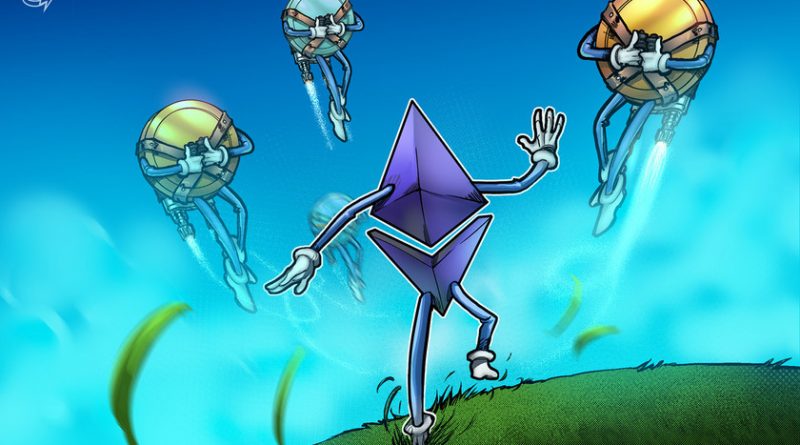As DeFi booms, Ethereum’s blockchain competitors are catching up
Decentralized finance participants eye a “multichain” future as Ethereum’s DeFi-powering peers continue to attract users and projects.
Ethereum is not the only blockchain platform seeing a significant increase in value as the decentralized finance space continues to move in tandem with the booming cryptocurrency ecosystem. The new year has continued to be good to the DeFi space, evident in the sheer amount of value that has been injected into various platforms.
The value staked in DeFi protocols briefly surpassed $27 billion on Jan. 20, according to DappRadar, driven in part by the increase in value of a large majority of cryptocurrency tokens. Nevertheless, the space has seen growing adoption and development in recent months.
Ethereum currently holds the mantle as the most popular smart contract blockchain application for developers and projects on which to build and launch apps and platforms. The DeFi space is intrinsically linked with Ethereum in its current state, with a large majority of the biggest DeFi projects and protocols running on its blockchain. Uniswap, the biggest automated market maker according to DeFi Pulse, runs on Ethereum, while the rest of the top 10 DeFi projects listed also operate on the blockchain network.
While the growth and success of DeFi platforms have put a strain on the Ethereum network’s ability to process transactions and have increased fees, these platforms have led to an enormous amount of value being locked in the Ethereum ecosystem. With that being said, a couple of Ethereum’s market competitors are enjoying resounding success in early 2021, suggesting that there are more participants pushing the pace in the DeFi space.
Polkadot, Chainlink and Near Protocol see big gains
Polkadot is seen as one of the most prominent rivals to Ethereum. It’s a new-generation blockchain that connects private and public blockchains and networks. The project was started by the Web3 Foundation and hopes to drive interoperability between blockchains to power a decentralized internet of the future.
Polkadot essentially operates a multichain protocol using what it calls “parachains,” which allow other blockchains to connect to its network as sidechains. The protocol also has the capacity to handle thousands of transactions per second, which has pitted it against Ethereum in the eyes of some commentators. Polkadot has seen immense growth in 2021, with its DOT token’s price nearly doubling since the start of the new year.
Near Protocol is another smart contract blockchain platform that has been growing in popularity since its launch in April 2020. Its native token, NEAR, recently saw a rise of more than 100% in value. The project operates on its own proof-of-stake protocol that uses sharding, which Ethereum is still working toward implementing this year.
Cardano, which runs on its own proof-of-stake blockchain, has also seen some growth. Its native token, Ada, moved past Bitcoin Cash (BCH) to become the six-largest cryptocurrency by market capitalization. The platform has yet to roll out functional smart contract capability but is expected to do so this year, which will allow DeFi platforms to be built on the protocol.
Chainlink is also featured on this list for its role in the smart contract blockchain and DeFi space. Chainlink is a decentralized oracle network that serves as an intermediary providing data to smart contracts on different blockchains. According to the project, Chainlink has become a major tool for the DeFi space, as it provides tamper-proof, high-quality price data to various DeFi protocols.
The network’s native token, LINK, moved into the top 10 biggest cryptocurrencies by market capitalization in January as Chainlink continues to enjoy the indirect effects of DeFi’s success.
The phrase “The Great Repricing” was thrown around in the DeFi space as the native tokens for popular platforms Synthetix and Aave also moved into the top 20 cryptocurrencies by market cap early in the new year. Synthetix Network Token (SNX) and AAVE have seen considerable growth in value and have a combined market cap of over $3.5 billion. SNX is the native token of Synthetix, a derivatives liquidity protocol, while Aave is a liquidity protocol that allows users to deposit and borrow various cryptocurrency assets. Both run on the Ethereum blockchain.
Plenty of room for rival chains
The DeFi space is clearly a burgeoning sector that has plenty of room for more than one blockchain to power the plethora of applications and offerings that have been developed over the past year. Dan Reecer, head of Polkadot growth at the Web3 Foundation, acknowledged that Ethereum is the incumbent leader in the DeFi space by total value locked.
However, that does not mean that users are not willing to try alternatives, according to Reecer: “The surge in DeFi platforms built on blockchains other than Ethereum is absolutely a clear sign that DeFi, crypto, and blockchain in general is becoming multi-chain.” He also stressed that a move to a multichain DeFi ecosystem will become a necessity in the future, considering how centralized, mainstream applications and networks currently operate:
“In comparison to traditional tech, all of our most used apps, the Instagrams and LinkedIns of the world, are using a wide variety of major database systems. These databases, along with the rest of the piping and protocols of the internet, all operate together seamlessly. For DeFi and crypto to flourish in all age groups at scale, we need to get to a multi-chain infrastructure all operating in tandem. Most importantly, the user should not know what underlying protocol or blockchain they are even using.”
Bette Chen, co-founder and chief operating officer of decentralized finance “hub” Acala, told Cointelegraph that the DeFi space is still in its infancy, as an average of just 4,000 to 5,000 addresses are active every day.
Nevertheless, Chen believes that the emergence of new smart contract blockchains is a positive development for the DeFi space: “We don’t think in the frames of competition, we’re at the very early stage of a new disruptive technology, we think the multi-chain future that we are evolving into will collectively grow the DeFi space and help mass market adoption.” She went on to add that it will likely be “a hybrid of CeFi and DeFi offerings that help deliver the real values and user experiences to end users.”
Pavel Bains, co-founder and CEO of decentralized data hosting project Bluzelle, told Cointelegraph that Ethereum’s dominance might not necessarily be threatened, but its transition to Ethereum 2.0 is becoming increasingly important, as other protocols already offer the capabilities it’s working to incorporate:
“The best thing Ethereum can do right now is delivering advancement for Ethereum 2.0 every few months. Even if it’s just baby steps, developers will be less likely to switch platforms knowing that 2.0 is almost here. Right now I don’t think it’s threatened. But I do hope it is and it’s better for the whole ecosystem.”
As Reecer said, competition is always healthy for an industry, and he noted that the cryptocurrency space is no exception. He stressed that Ethereum’s percentage share of TVL, users and developers in the broader ecosystem will depend on the project’s ability to scale and keep pace with its peers, especially sharded, multichain ecosystems: “It’s likely not rational to expect there to be 10-20+ protocols that win out in the end. This decade should see chain mergers and acquisitions, some teams fizzling out, and a handful of FAANG-esque winners emerging for the long haul.”




